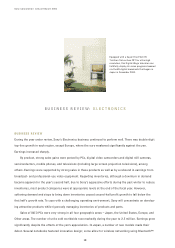Sony 2001 Annual Report Download - page 29
Download and view the complete annual report
Please find page 29 of the 2001 Sony annual report below. You can navigate through the pages in the report by either clicking on the pages listed below, or by using the keyword search tool below to find specific information within the annual report.
Sony Corporation Annual Report 2001
27
the time. Sony plans to take advantage of the wide viewing angles,
excellent contrast and vivid colors of these displays to create thin
televisions and other large-screen displays ranging from 10 to 30 inches.
In April 2001, Sony and Universal Display Corporation of the United
States agreed to cooperate in the development of OEL displays using high-
luminescence materials. Combining Universal Display’s high-efficiency
electrophosphorescent materials with Sony’s OEL display expertise is
expected to lead to displays with a longer life. The two companies will now
accelerate development of technologies to realize such displays.
Functioning as interfaces linking people with content and services
offered over networks, display devices are an essential element of the
coming broadband era. In line with this thinking, Sony will speed up
research and development of display device technologies that offer
future promise, including OEL displays. Sony aims to apply such technologies to thin,
wall-mounted televisions, computer displays, and other innovative products.
NETWORK-RELATED TECHNOLOGIES
Looking towards the growth of wireless broadband services, Sony has developed the
OpenMG Light copyright protection and distribution system for digital content sent to
mobile devices. This greatly enhances the capabilities of mobile phones, PDAs, and other
mobile devices by compressing OpenMG, which is currently used to protect copyrighted
music stored by PCs, into a small, client/server format. This overcomes the restrictions
imposed by the compact size of mobile devices to bring OpenMG’s copyright protection
to the wireless world. Making this software still more attractive for wireless applications
is the ability to resume transfer after an interruption.
This software for copyright management and distribution of music, video, and other
digital content is not only for mobile devices. In the future, Sony envisions extending its
use to a broad range of other networking devices. At the same time, Sony will urge other
related companies and industries to adopt OpenMG Light.
During the year, Sony developed Top
emission Adaptive Current drive
(TAC) technology, making possible a
large-scale Active Matrix Organic
Electroluminescence (OEL) display
driven by low-temperature
polysilicon TFTs. A full-color 13-inch
prototype, the largest in the world at
the time, was made public in
February 2001.
























